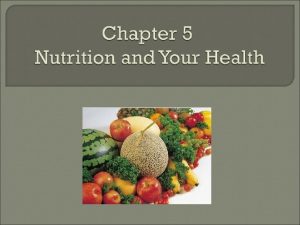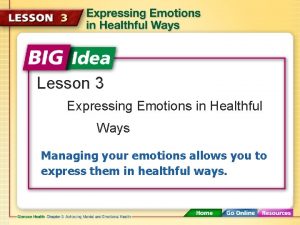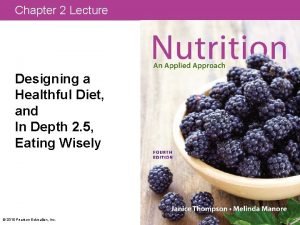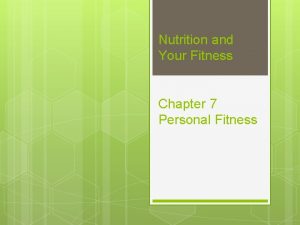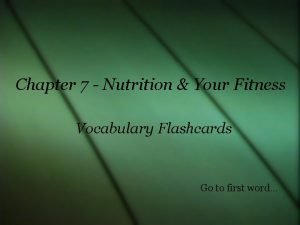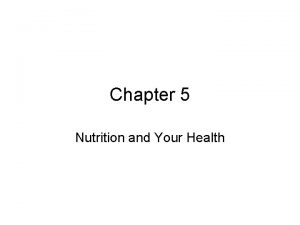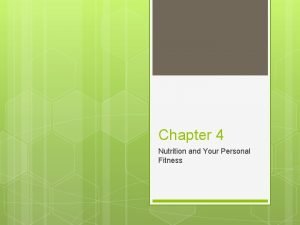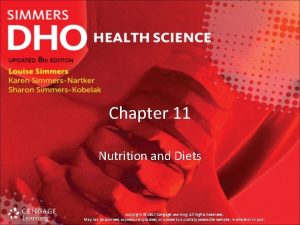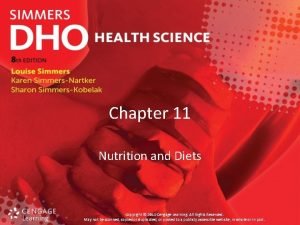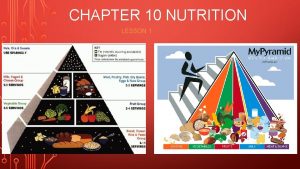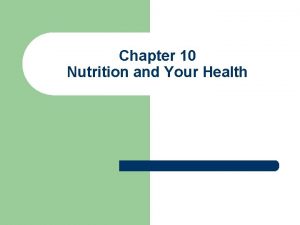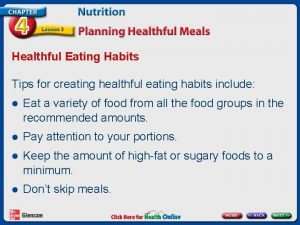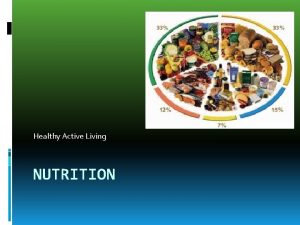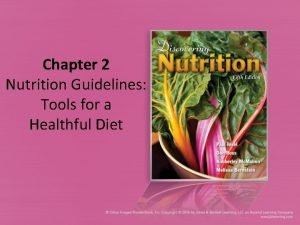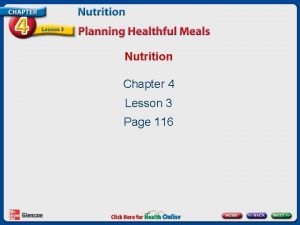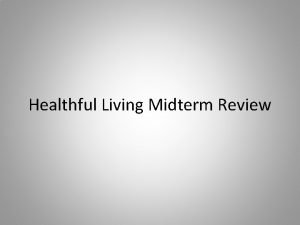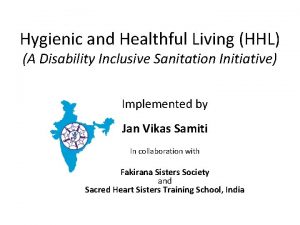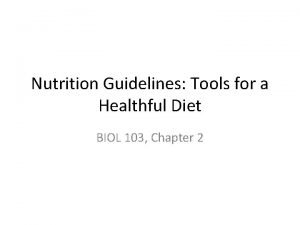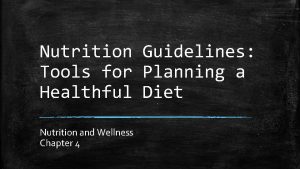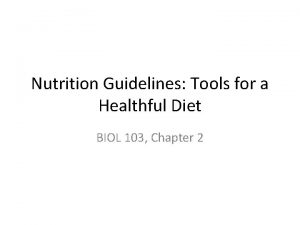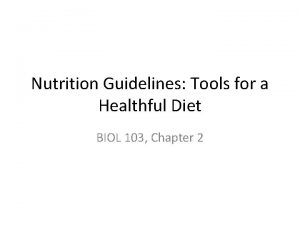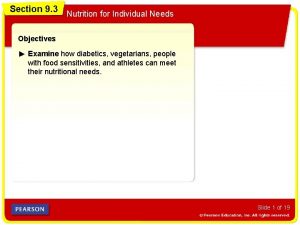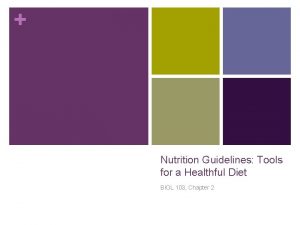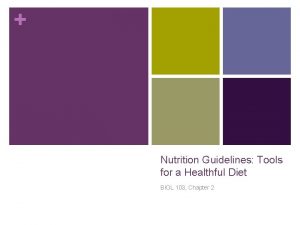Chapter 30 HEALTHFUL LIVING 30 1 Nutrition and















- Slides: 15

Chapter 30 HEALTHFUL LIVING 30. 1 Nutrition and Diet 30. 2 Stress and Physical Fitness © Thomson/South-Western CHAPTER 30 Slide 1

Lesson 30. 1 NUTRITION AND DIET Objectives n Describe how the My. Pyramid system is used in choosing a healthful diet n Identify your own recommended weight and daily calorie needs © Thomson/South-Western CHAPTER 30 Slide 2

Lesson 30. 1 EATING RIGHT n Nutrition is the process by which plants and animals take in and use food. n Nutrients are chemical substances in food that are needed for good health. n Nutrients n Serve as fuel to provide energy n Help regulate body processes n Furnish basic materials for building, repairing, and maintaining body tissues © Thomson/South-Western CHAPTER 30 Slide 3

Lesson 30. 1 GRAINS VEGETABLES FRUITS MILK MEAT & BEANS Make half your grains whole Vary your veggies Focus on Fruits Get your calcium-rich foods Go lean with protein © Thomson/South-Western CHAPTER 30 Slide 4

Lesson 30. 1 CALORIES AND WEIGHT n Calories are units of energy produced by food when it is used by the body. n Sedentary means inactive. n Basal metabolism is the minimum amount of energy (calories) necessary for continuous body functioning. © Thomson/South-Western CHAPTER 30 Slide 5

RECOMMENDED WEIGHTS © Thomson/South-Western Lesson 30. 1 CHAPTER 30 Slide 6

Lesson 30. 2 STRESS AND PHYSICAL FITNESS Objectives n Name and illustrate three major ways to reduce or eliminate stress n Discuss benefits of physical exercise n Name and describe three types of exercises that should be included in a workout © Thomson/South-Western CHAPTER 30 Slide 7

Lesson 30. 2 STRESS n Stress is mental, physical, or emotional strain. n An unavoidable part of life n Stressors are events, activities, experiences, or situations that cause stress. n Stressors may be good or bad. n Stressors may range from mild to severe. © Thomson/South-Western CHAPTER 30 Slide 8

Lesson 30. 1 MOST COMMON CAUSE OF STRESS n Daily activities, events, frustrations, and challenges n Illness or injury n Extreme conditions such as heat, noise, or air pollution n Life changing events n Life crises © Thomson/South-Western CHAPTER 30 Slide 9

Lesson 30. 2 CONTROLLING STRESS n Plan how to deal with stress n Learn how to relax n Change your life © Thomson/South-Western CHAPTER 30 Slide 10

Lesson 30. 2 PHYSICAL FITNESS n Physical fitness refers to how well your heart and other organs function. © Thomson/South-Western CHAPTER 30 Slide 11

Lesson 30. 2 BENEFITS OF EXERCISE n Improves strength, endurance, and coordination n Aids in weight control, thus helping to ward off ailments associated with being overweight n Helps ensure the proper growth and development of young bones and muscles © Thomson/South-Western CHAPTER 30 Slide 12

Lesson 30. 2 BENEFITS OF EXERCISE (continued) n Improves the ability to avoid and recover from illnesses and accidents n Strengthens muscles that support the body, improving posture and appearance n Increases poise by developing grace and ease of movement n Reduces stress, thus acting as a natural tranquilizer © Thomson/South-Western CHAPTER 30 Slide 13

Lesson 30. 2 TYPES OF EXERCISES n Flexibility exercises n Endurance exercises n Aerobic exercises are exercises that condition the heart and lungs by increasing the body’s ability to take in oxygen. n Strength exercises © Thomson/South-Western CHAPTER 30 Slide 14

Lesson 30. 2 GUIDELINES FOR PHYSICAL FITNESS n n n Do not keep finding excuses not to exercise. Do not think of fitness as a crash program. Enjoy yourself. Do not set unrealistic expectations. Vary your exercise routine. Once you get in shape, keep up your exercise program. n Avoid harmful habits that can undo the benefits of exercise. © Thomson/South-Western CHAPTER 30 Slide 15
 A natural physical drive that prevents starvation
A natural physical drive that prevents starvation Venn diagram living and nonliving things
Venn diagram living and nonliving things Three strategies for handling anger in a healthful way
Three strategies for handling anger in a healthful way Intentional use of unfriendly or offensive behavior
Intentional use of unfriendly or offensive behavior Is a moss living or nonliving
Is a moss living or nonliving Living non living dead
Living non living dead Smallest living unit of life
Smallest living unit of life Serving size examples
Serving size examples Kelsey carbonetta
Kelsey carbonetta Chapter 7 nutrition and your fitness
Chapter 7 nutrition and your fitness A saturated fatty acid holds all the hydrogen atoms it can.
A saturated fatty acid holds all the hydrogen atoms it can. Chapter 4 nutrition and your personal fitness
Chapter 4 nutrition and your personal fitness Chapter 11 nutrition and diet
Chapter 11 nutrition and diet Test chapter 11 nutrition and diets
Test chapter 11 nutrition and diets Chapter 10 lesson 4 nutrition labels and food safety
Chapter 10 lesson 4 nutrition labels and food safety Chapter 10 lesson 4 nutrition labels and food safety
Chapter 10 lesson 4 nutrition labels and food safety
